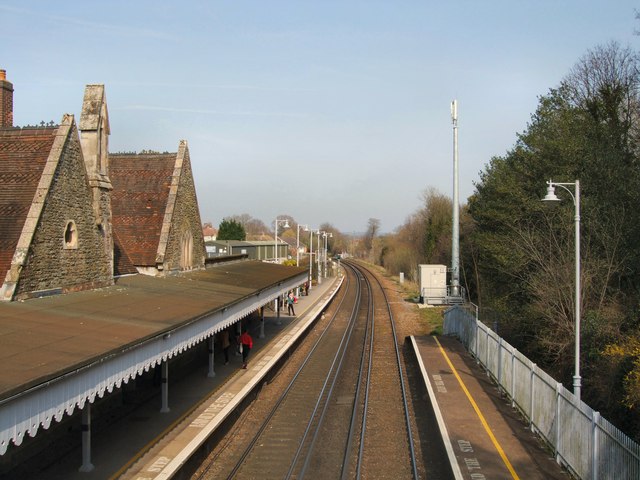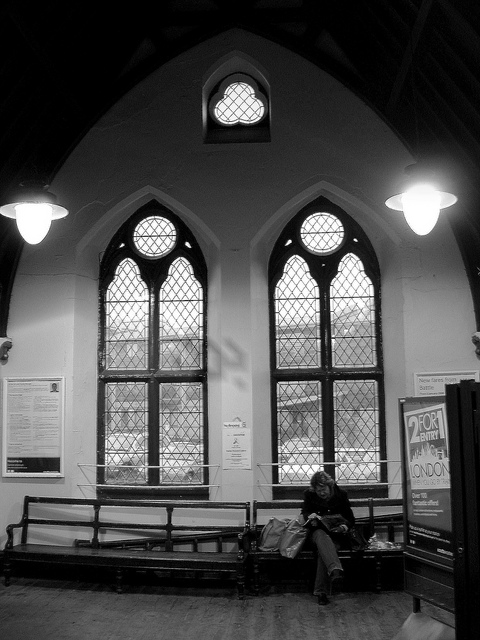When people talk about Gothic architecture on the railways, they usually mean this:

George Gilbert Scotts’s Midland Grand Hotel at St Pancras is Victorian High Gothic of the sort you’ll also find at some of the grandest country houses of the period, not to mention public buildings like the Palace of Westminster. But there was another sort of Victorian Gothic altogether, on a much more domestic scale, less colourful and with fewer pointy bits. Something a bit easier to live with, in other words. Countless houses were built in this style, and so was the odd railway station, including this week’s transport beauty. It’s a world away from the grandeur of the Midland Grand, but for my money, after St Pancras itself this is the next-best Gothic railway station in the country. It’s in Battle, East Sussex.

Battle is an oddly-named village. It grew up around Battle Abbey, which was not-quite-named for the Battle of Hastings, itself named after the nearest settlement of any consequence at the time. William the Conqueror, one has to assume, decided that it wasn’t necessary to state which battle he was celebrating by founding the Abbey. As far as he was concerned the Battle of Hastings was simply the battle, so that was what the abbey was called. So now there’s a town called Hastings where the Battle of Hastings didn’t happen, and small town called Battle where the battle did happen, but it doesn’t share a name with the famous battle that happened there. I strongly recommend not engaging Battle’s residents in conversation about this state of affairs.
The South Eastern Railway reached Hastings via Tunbridge Wells in 1852, and Battle was one of the places served by the line. We’re still in the early days of the railways here, just a few years after the construction of the Classically-styled stations at Whitby and Scarborough. Battle station, like Whitby and Scarborough, used reassuring architecture to combat Victorian fear of the rapidly expanding railway network, although it was finished in a different architectural style.
The South Eastern Railway’s architect was William Tress, whose tastes ran to the eclectic, meaning that his station architecture spanned Gothic to Italianate via the Florentine Rennaisance. He had one eye on his local surroundings at Battle (rather like King Harold, albeit for a different reason). Battle Abbey is genuinely Mediaeval. Its ruins date from the 13th Century; replacements for the earlier abbey William the Conqueror founded. The Victorian revival of Gothic architecture handily provided Tress with a way of making Battle station blend in with Battle’s most famous building. It also provided him with a way of reaching back into Britain’s long history and dressing up a disruptive new technology in reassuringly long-standing clothes. Historic England, which listed the station at Grade II in 1987, describes Battle station as resembling a Victorian vicarage, a building type for which domestic Gothic became almost de rigueur. That reassuring similarity would have been exactly what Tress was going for.

On the outside, Battle’s station building is finished in coursed stone, and it has steeply pitched roofs with patterned tiles. The windows are tall and narrow, with the pointed arches that typify Gothic architecture, and are glazed with latticed glass. The windows on the ticket office are the most ornate, featuring stonework mullions and a small circular window at the top. Above these, high up on the gable end, is a trefoil window which would be as much at home in a church as it is here. Squat little buttresses (which I suspect are more ornamental than useful) lean against the building at each end, while impressive stepped chimney stacks reach from first floor level up above the roof line. There’s even a funny little bell tower structure on the platform side of the building.

The ticket hall is superbly atmospheric, open to the wooden roof and complete with wooden floor. And yes, it feels exactly like a grand old vicarage when you wait there.

And yet… for all that it looks backwards to Mediaeval times, and for all that it’s a typical early railway attempt to disguise a station in reassuringly pre-existing architecture, Battle is a station where you can see genuine railway architecture beginning to assert itself. Strip away the Gothic styling and in basic plan and form, this is a building which could be the template for hundreds of small stations which would subsequently be built right across the country. There’s the combined ticket office and waiting room, with doors to the forecourt and onto the platform at opposite ends, and the ticket office off to the side. There’s the adjoining two-storey station house. At either end, the station building steps down to single-storey extensions. Battle station’s design is not a million miles away from something like Horsley station, as typical a country railway station as you’re ever likely to see. By the time Horsley station was built in 1885, public confidence in the technology of the railway was inestimably higher, and station architecture was something recognisably of its own.

Battle stands right on the boundary of the early dissembling-but-reassuring railway architecture, and the later confident and un-self conscious railway architecture, which makes it doubly fascinating.
It’s also a station which is personally important, and to which I have a particular attachment. I grew up in Hastings, but we lived on the north side of town. It was just as convenient for my family to use Battle station as it was Hastings station itself. Hastings station was nearer, but it meant wiggling through town to get there. Battle was a little further away, but easier to get to, and the train journey from there to London was shorter because we cut out the wiggly bit via St Leonards and Crowhurst that the train does between Hastings and Battle.
So Battle station was the start of days out to London. After I left home, Battle station also came to mean returning to my parents. Living in Birmingham and then London, there was something special about stepping off the train at Battle late in the evening, and finding my father waiting to give me a lift back to my old house. There was the smell of clean air, rather than the fumes of the city, and the promise of proper food, and perhaps getting my washing done (the laundry at university was tiny, otherwise I’d have done it there more often. Honest).
When you want to know why there are so many greetings cards, games, jigsaws, calendars and the like that feature transport rather than the myriad of other industries which the modern world has given rise to, it’s transport’s emotional resonance that provides the explanation. It’s why transport museums and preserved railways are so numerous and so enduringly popular. It’s why transport memorabilia is such big business. Transport, especially public transport, takes you to and from all the great experiences of your life, and is forever bound up with them. The buses, trains and trams that took you to school, your first job, nights out at college, to see friends, to meet your lover, to go on holiday, all contribute to the substance of who you are. The stations and bus stops where you got on or off become part of your emotional history, markers on a psycho-geographic map of the world unique to you.
Few other industries have such an impact. Unless you met your spouse in a supermarket aisle, supermarkets are never going to claim the same emotional power over you as transport does. That’s why we visit preserved railways and transport museums, and send each other cards with steam trains and vintage buses on them. It’s to try to recapture something of the importance those journeys held for us at the time. It’s to try to show our children something about what the world was like, back then, and how we lived in it, and how (even if we can’t articulate it, or don’t really think about it) transport was the enabler of it all.
The rise of the private car might have eroded public transport’s role in all this, but then I look at people obsessing over motorway service stations and realise it’s just another kind of transport worming its way into people’s emotional history. It’s not just the inherent architectural qualities of service stations that hold the appeal, I’m certain. You have to really like Brutalism to appreciate many of them. And it’s not because motorway service stations are especially pleasant places to be. But those service stations would have been stopping-off points on long-ago childhood adventures for many of their present day enthusiasts.
For whatever reason, most of us crave the connection to our pasts that transport accidentally provides. No wonder it has such an unusual cultural impact. Battle station is inherently important, and architecturally significant in its own right. The Sussex Industrial Society says it is the best small station in Sussex. But it’s my personal connection to Battle station, though I haven’t been there for years, that makes it so important to me.
Bibliography and Further Reading
Historic England’s listing citation for Battle station, here (NB – Historic England mis-spells Tress’s name as Trees in the listing)
Hoare, J. (1974) ‘Railway Architecture in Sussex’, Sussex Industrial History, 6, p. 15-24
‘I strongly recommend not engaging Battle’s residents in conversation about this state of affairs.’ I also strongly recommend not calling Battle a village within their earshot. It is most definitely considered a town.
Small town, then. Fixed.
So totally agree with you about how transport gets into our nostalgic impulses!
I’ve been interested in buses (in particular) all my life but certain types I’ve become fonder of because of association with certain aspects of my life!
For instance, West Midlands Travel’s 1990 batch of Alexander bodied Scania’s , bought primarily for route 50, will always, for me, be associated with the two years (1990-92) I spent studying Drama at the Friends Institute on Moseley Road.
Similarly, Birmingham route 60, to Cranes Park is forever etched in my psyche as the bus I caught to my Great Grandmothers, two stops away from the terminus. I could go on with the various connections, there are so many! Fascinating blog!
I grew up in Bexhill and when I am going home for a visit my mum often picks me up from Battle. This is a lovely article – so nice to see something so familiar with new eyes! I sent the link to my mum and she said, “An early story I heard about why Battle station looks as it does has to do with the Webster family who owned Battle Abbey and much of Battle then, including the land where the station stands. The story goes that when the railway line came through Battle, the railway company negotiated with the Websters to purchase the necessary land, and the Websters agreed on condition that the station should be designed to fit in with the historic feel of the place.” Do you know if that’s true?
I don’t know if that’s true. I’ve not read it anywhere, but it was the kind of thing that happened during the early development of the railway.